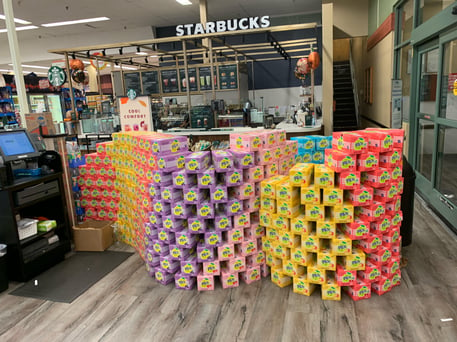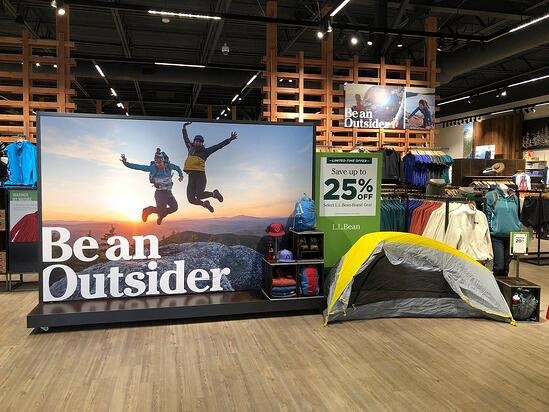In today’s world of retail, CPG companies spend on average up to nearly one-third of its revenue on trade promotions, and for good reason – it’s an easy and great differentiator to set themselves apart from competing brands. According to the PwC, when executed properly promotions can add 10-15 percent to the bottom line. But without mastering the art of promotions, it can certainly come with a heavy cost.
HBR reports that more than half of all promotions fail to have any impact on sales. Understanding how to properly implement and execution your in-store promotion could be the difference between seeing a huge sales lift or failing to break even.
As a merchandiser, what action steps can you take at retail to elevate the performance of your in-store promotions? We’ll explore that and more in this blog, but first let’s start with the basics.
What Are In-Store Promotions?
Slashed prices. Toilet paper roll towers. A throne made from seltzer packs. An entire shelf allocated to a single candy bar. Whatever it looks like, if you take charge of a product’s merchandising within the point of purchase, you’re executing an in-store promotion. Also commonly referred to as a trade promotion, this practice outlines the strategies developed in tangent between retailers and merchandisers.
Trade promotions are marketing tactics merchandisers use to directly influence product performance at retail. They often occur in-store to target direct shoppers actively making purchases, and when pulled off successfully they offer unparalleled reward.
In-store promotions can also help boost specific sales in underperforming locations, enter a new product into the market, shift established products into new markets, or raise general brand awareness.
Now that we’ve established how an in-store promotion works, let’s take a look at how to best implement them. A good promotion requires support from both customer-facing and internal directions. It’s a balance of good fiscal approach while saying the correct things. Attack promotions with both directions in mind. These four tips will do just that.
1. Reinforce the Product Narrative
While many buyers may already know your product, reinforcing it through off-shelf branding is a great way to attract new buyers. Brands that expand their presence beyond standard shelving forces customers to see their product – and considering customers ignore up to half of all shelved goods, it’s important to spread product visibility as much as possible.
In-store displays are also great at rebranding, and making your product more attractive to unsuspecting shoppers. Check out the many ways you can expand your brand off the shelf.
Smart Floor/Wall Displays
Try interrupting the customer shopping experience with a dedicated product presentation. Smart displays not only catch a few unsuspecting eyes, they also create a narrative around the product. Nike arranges their sneakers in a runner’s stance, capturing a sense of action and motion. The physical structure of displays--especially how customers move around them--establishes a passive engagement with your product. As you'll see below, Polar's Seltzer'ade line aims to attract buyers with its refreshing colorful display made out of its signature eight-packs.
Banners, Signs, and Floor Stickers
Raise brand awareness and distinguish your product from the monotony of standard packaging. Good posters are fun and feature recognizable figures--athletes and celebrities--participating in the product. Unlike displays, maintenance is minimal.
Understand the product narrative, then standardize. L.L. Bean uses their promotional space marketing to an outdoorsy crowd. A good story shows the “how” of your product, creating a need while never explicitly stating one.
(Source: @LLBeanMashpee on Twitter)
Added Premiums
Add bonus incentives with the purchase of your product. Premiums are fun, supplementary perks that come with purchase. You may recognize a famous premium from the past: Coors, who ran a campaign that included portable beer coolers with each 36 pack purchase.
By adding a premium, you can also shape the narrative of your brand as well. By packing their beers in a reusable travel cooler, Coors adopted a symbolic “take this on the road” approach to community drinking. Portability implies tailgates, cookouts, the beach, any outdoor event. The extra incentive stapled with your product turns otherwise hesitant buyers to sale.
2. Strategic Price Discounts
Experimenting with temporary price reductions (TPRs) can have a dramatic impact on sales promotion activities. Below are a few of the more common price reductions, but with a little bit of creativity, every brand can devise a unique way to sell their product.
Coupon Integration
If used effectively, coupons can further entice buyers to purchase. They insert the product in the customer’s attention, even if they had no intention to originally purchase that product. What also makes coupons great is that they can be handed out anywhere and everywhere. Some can be found on the actual product, while some can also be at the registers or even floor displays.
The key with coupons is to create a sense of urgency with deadlines. Coupons must expire. People fear missed opportunities on deals – if used correctly, coupons can be that last push that turns potential customers into realized sales.
Temporary Price Reductions
There’s nothing more a shopper loves than seeing prices slashed through with 20 percent off tags.
Make customers stand still and really observe what you’re offering. Getting this full level of attention is the hardest part of product marketing, but the best way to maximize purchase probability. Use exciting colors for sales tags; red works especially well to catch the eye.
Explicitly show the before and after pricing. By putting the idea of savings in their heads, you are indirectly imprinting the concept of a completed sale. At the very least, mental math requires a literal slow down in movement--an important key point in selling.
Buy One Get One Free (BOGO)
Also referred to as “the bonus pack” or the "two-for," Buy One Get One promotions can be as literal as an extra tube of toothpaste per unit or as conceptual as 20 percent more laundry detergent per bottle.
One thing we know for sure is that "Free" lowers the barrier of entry. Untapped customers see this as a trial for your product, gaining brands entry into a new market. The increased quantity of product encourages repeat customers to purchase in larger quantities to prepare for future need.
There is perceived value to the consumer in getting something “for free.” “A 2 for $5 is more effective vs. $2.49 each. If you have a 2-for, you will almost guarantee every customer will buy the multiple”, reports Perry Abbenante, VP of Marketing for Pretzel Crisps.
3. Communicate the Right Questions with Store Managers
Did you know optimal shelving can sway sales by as much as 10 percent? While it’s clear that not all shelves are treated equally by customers, if a product could be performing better in a different facing, you may want to address this with the store manager, and be sure to have data points to support your case.
Additionally, while out-of-stock (OOS) levels in retail stores are approximately 8 to 10 percent, research has shown twice that level for promotional items, making these conversations with managers even more crucial to the success of your brand promotions. To maximize sales, every field agent must determine the following:
- Is our product properly stocked?
- Is the product kept in good condition?
- Do we have available space to capitalize on?
- How many facings do we have?
- How much shelf space does our competition occupy?
If sales numbers don’t quite add up to projections, double back with tight audits at the store to accurately diagnose what problems you see your brand is facing, and if necessary, address those issues with that manager. These conversations are only the start of a longer retail audit process all brands must employ to see tangible growth.
4. Validate Promotional Success with Data
Numbers truly speak and just this past year, overwhelmingly, 70 percent of companies reported that they struggle with compliance and in-store execution on retailer aligned promotions. Nothing will crush the potential of an in-store promotion faster than noncompliance. And the worst part is – you could’ve done something about it. Fortunately, winning brands know that tasty data points and positive trends put brands in good faith with retailers and can even save a failing promotion in-flight.
Some metrics are better at building a complete narrative than others. But when it comes to measuring the success of an in-store promotion, incremental revenue and the marginal return on investment are the two key metrics that can extended onto every family of promotion that we find most valuable.
Incremental Revenue
This calculates the change in revenue associated with the promotion. Your return during the campaign may be positive, but did it perform better than usual? And how does this compare to other locations that ran the same promotion? By assessing this data across the board, you can build your daily schedule around which stores need a check-in.
This calculation measures the change in sales from promotions. By using historical sales data as a baseline, incremental revenue is calculated by finding the difference between sales under a promotion and what would be expected under the same timeframe.
Positive incremental revenue shows your promotion raised sales above your baseline. Negative incremental revenue shows the opposite. As an important note, this only examines customer engagement with your product, not overall fiscal success of the promotion. The greater the incremental revenue, the stronger customers responded to this approach.
Marginal Return on Investment
Return on investment calculations are critical to understand any business strategy. Marginal return on investment takes this a step further by highlighting the room for growth running a particular strategy in a particular market.
The higher the mROI, the faster your standard return grows with each further invested dollar. When mROI hits “1,” dollars become inefficient, with each extra dollar added failing to boost ROI in a meaningful way. We break down this process further in our guide to proper trade spend practices.
By blending these two calculations together, you learn what in-store promotions resonate with customers while maximizing your invested capital.
By attacking in-store promotions with these four tactics, you’ll begin to see a lift on your sales goals in no time. To learn more about how to take advantage of in-store promotions, check out our eBook on the Ultimate Guide to Trade Promotions. From data-driven targeting and planning to trade promotion optimization and management, we cover everything you need to know about how to take a data-driven approach to trade promotions.








